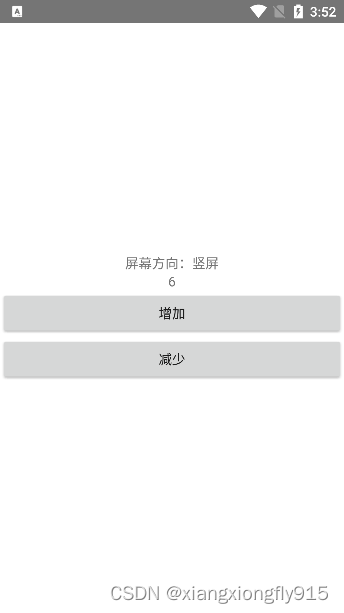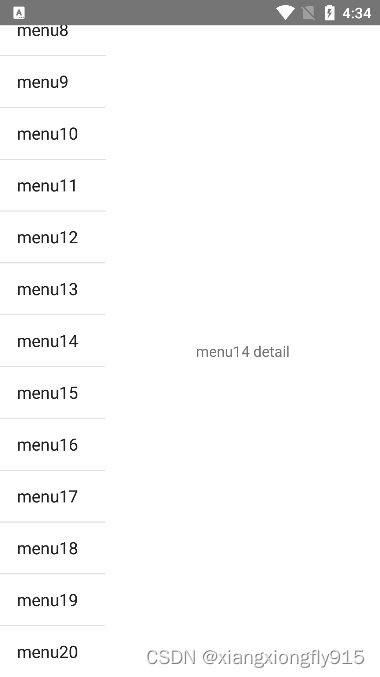文章目录
- Jetpack ViewModel
- 概述
- 添加依赖库
- ViewModel的生命周期
- 基本使用
- AndroidViewModel
- Fragment之间共享数据
- ViewModel与onSaveInstanceState()区别
- 代码下载
Jetpack ViewModel
概述
ViewModel 类目的在于以注重生命周期的方式存储和管理界面相关数据。ViewModel类让数据可在发生屏幕旋转等配置更改后继续留存。
添加依赖库
//ktx
implementation "androidx.activity:activity-ktx:1.2.3"
implementation "androidx.fragment:fragment-ktx:1.3.6"
//Lifecycle
def lifecycle_version = "2.5.0"
//LiveData
implementation "androidx.lifecycle:lifecycle-livedata-ktx:$lifecycle_version"
implementation "androidx.lifecycle:lifecycle-common-java8:$lifecycle_version"
implementation "androidx.lifecycle:lifecycle-process:$lifecycle_version"
//ViewModel
implementation "androidx.lifecycle:lifecycle-viewmodel-ktx:$lifecycle_version"
ViewModel的生命周期
ViewModel 对象存在的时间范围是获取 ViewModel 时传递给 ViewModelProvider 的 Lifecycle。ViewModel 将一直留在内存中,直到限定其存在时间范围的 Lifecycle 永久消失:对于 Activity,是在 Activity 完成时;而对于 Fragment,是在 Fragment 分离时。
由于ViewModel的生命周期长于Activity,因此不能将View或者Activity的context传给ViewModel,否则会引起内存泄露。

基本使用


ViewModel类实现
class MyViewModel : ViewModel() {
private val _countLiveData = MutableLiveData<Int>()
val countLiveData = _countLiveData
private var count = 0
fun increase() {
_countLiveData.postValue(++count)
}
fun decrease() {
_countLiveData.postValue(--count)
}
}
获取ViewModel对象,方式一
var viewModel: MyViewModel = ViewModelProvider(this).get(MyViewModel::class.java)
获取ViewModel对象,方式二
val viewModel: MyViewModel by viewModels()
在Activity中使用
class ViewModelSimpleActivity : BaseActivity() {
private lateinit var tvCount: TextView
private lateinit var tvScreen: TextView
private val viewModel: MyViewModel by viewModels()
override fun onCreate(savedInstanceState: Bundle?) {
super.onCreate(savedInstanceState)
setContentView(R.layout.activity_view_model_simple)
Log.e(VIEWMODEL, "onCreate")
initView()
val screenOrientation =
if (resources.configuration.orientation == Configuration.ORIENTATION_PORTRAIT) "竖屏" else "横屏"
tvScreen.text = "屏幕方向:$screenOrientation"
viewModel.countLiveData.observe(this, object : Observer<Int> {
override fun onChanged(t: Int?) {
Log.e(VIEWMODEL, "onChanged")
tvCount.text = t.toString()
}
})
}
private fun initView() {
tvCount = findViewById(R.id.tv_count)
tvScreen = findViewById(R.id.tv_screen)
}
fun clickIncrease(v: View) {
viewModel.increase()
}
fun clickDecrease(v: View) {
viewModel.decrease()
}
override fun onDestroy() {
super.onDestroy()
Log.e(VIEWMODEL, "onDestroy")
}
}
AndroidViewModel
因为ViewModel对象的存活时间较长,因此不能将Activity的Context传递给ViewModel,否则会引起内存泄露。如果需要使用context,这时可以使用AndroidViewModel接收Application的对象。
class MyAndroidViewModel(application: Application) : AndroidViewModel(application) {
private val _countLiveData = MutableLiveData<Int>()
val countLiveData = _countLiveData
private var count = 0
fun increase() {
_countLiveData.postValue(++count)
}
fun decrease() {
_countLiveData.postValue(--count)
}
}
Fragment之间共享数据
优点:
- Activity不需要做其他操作
- Fragment之间没有任何干扰,只需要约定ViewModel

SharedViewModel类
class SharedViewModel : ViewModel() {
private val _liveData = MutableLiveData<String>()
val liveData = _liveData
fun select(item: String) {
_liveData.postValue("$item detail")
}
}
Activity类
class MenuActivity : BaseActivity() {
override fun onCreate(savedInstanceState: Bundle?) {
super.onCreate(savedInstanceState)
setContentView(R.layout.activity_menu)
supportFragmentManager.beginTransaction()
.add(R.id.fl_menu, MenuFragment.newInstance())
.add(R.id.fl_detail, DetailFragment.newInstance())
.commit()
}
}
MenuFragment
class MenuFragment : BaseFragment() {
private val sharedViewModel: SharedViewModel by activityViewModels()
companion object {
fun newInstance() = MenuFragment()
}
override fun onCreateView(
inflater: LayoutInflater, container: ViewGroup?,
savedInstanceState: Bundle?
): View? {
// Inflate the layout for this fragment
return inflater.inflate(R.layout.fragment_menu, container, false)
}
override fun onViewCreated(view: View, savedInstanceState: Bundle?) {
super.onViewCreated(view, savedInstanceState)
val listView = view.findViewById<ListView>(R.id.listView)
val data = ArrayList<String>().apply {
for (i in 0..20) {
add("menu$i")
}
}
listView.adapter = ArrayAdapter(mContext, android.R.layout.simple_list_item_1, data)
listView.setOnItemClickListener { parent, view, position, id ->
sharedViewModel.select(data[position])
}
}
}
DetailFragment
class DetailFragment : BaseFragment() {
private val sharedViewModel: SharedViewModel by activityViewModels()
companion object {
fun newInstance() = DetailFragment()
}
override fun onCreateView(
inflater: LayoutInflater, container: ViewGroup?,
savedInstanceState: Bundle?
): View? {
return inflater.inflate(R.layout.detail_fragment, container, false)
}
override fun onViewCreated(view: View, savedInstanceState: Bundle?) {
super.onViewCreated(view, savedInstanceState)
val textView = view.findViewById<TextView>(R.id.textView)
sharedViewModel.liveData.observe(viewLifecycleOwner, object : Observer<String> {
override fun onChanged(t: String?) {
textView.text = t
}
})
}
}
ViewModel与onSaveInstanceState()区别
- ViewModel:适用于配置变更导致的数据恢复,这是因为内存容量相对较大,可以存储较多的数据。
- onSaveInstanceState():适用于被系统回收后重建时的数据恢复,这是因为系统回收时应用进程会消亡,因此不能用内存存储而是使用持久化存储,同时这部分数据需要通过Bundle机制传输数据,Bundle缓冲区有大小限制,只能适用于小规模数据。
| ViewModel | onSaveInstanceState() | |
|---|---|---|
| 存储方式 | 在内存中 | 序列化在磁盘 |
| 读写效率 | 高(内存中访问) | 较慢(需要序列化、反序列化操作) |
| 配置更改后,数据是否留存 | 是 | 否 |
| 系统回收后,数据是否留存 | 否 | 是 |
| 使用场景 | 屏幕旋转等配置更改后保存 | Activity异常销毁时才会被调用 |
| 存储限制 | 可存储复杂数据,存储大小受App可用内存影响 | 只能存储可序列化对象,有存储大小有限制(一般为1M) |
代码下载
最后
以上就是爱笑铃铛最近收集整理的关于Android ViewModel使用Jetpack ViewModel的全部内容,更多相关Android内容请搜索靠谱客的其他文章。
本图文内容来源于网友提供,作为学习参考使用,或来自网络收集整理,版权属于原作者所有。








发表评论 取消回复